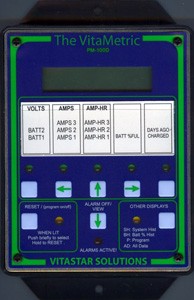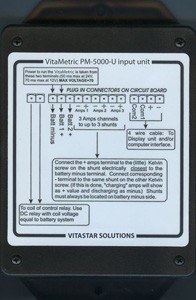Services & Products
VAR – Value Added Reseller
Battery Test and Monitoring
VitaMetric/PentaMetric Battery Test and Monitoring Device
Features
- Complete system consists of 3 parts: Input unit (near batteries), Display unit (shown above) and computer interface unit
- Monitor up to 3 shunts--For example: measure total solar input and wind input independently in addition to monitoring battery "state of charge"
- Access the data with display unit (shown above) with LCD display and buttons up to 1000 feet from batteries.
- Optional computer interface with (Windows) software to control and read out all data.
- Extensive system logged data
- Relay output to control generator or external alarm
- Audible and visual alarms for high and low battery conditions
- System cost: from under $400 (with computer interface only) to under $600 (with everything except shunts, temperature sensor and interconnection wiring).

Basic measurements:
Volts (2 channels) 8-100 volts. For example you can monitor volts from two battery systems. Or battery voltage, plus the solar array voltage if you have a peak power point tracking controller.
Amps, (3 channels) ±.01-200 Amps (with 100A/100mV shunt).± 0.1-1000 Amps (with 500A/50mV shunt) Each of these requires a separate shunt. There are many different ways these can be used. For example one channel can be used to keep track of battery system energy content and the two remaining ones can be used for separate measurement of two charging sources, such as total solar or wind production. Or two battery systems can be separately monitored if they share a common negative connection--and in addition one charging source could be separately monitored.
Temperature -20 to +65 degrees C.
Secondary measurements derived from basic measurements:

Amp hour (3 channels) to ±83,000 Amp-hours
Cumulative (negative) battery amp hours. (2 channels) to -1,000,000 amp-hours
This measures accumulated amp hours (usually from a battery) only when the amps value is negative. Its purpose is to measure the total cumulative 'wear' of batteries during their lifetime.
Smoothed (time filtered) Amps, with time constants of 0.5, 2 or 8 minutes (3 channels)
±.01-200 Amps (100A/100mV shunt).± 0.1-1000 Amps (500A/50mV shunt) For example, this can be used to show a more accurate estimate of wind charging input when the wind source is varying in speed.
Smoothed (time filtered) Volts (2 channels) 0-100 Volts. The smoothed values for both Amps and Volts are used for triggering "alarm" and relay functions so very short term anomalies will be ignored.
Watts(2 channels) ±.01- 20,000 watts
Watt-hours(2 channels) ±21,000 kilowatt hours?
Battery %full (2 channels) 0-100%
Days since batteries charged (2 channels) .01-250 days
Days since batteries equalized (2 channels) .01-250 days
Data Logging Functions:
There are 3 types of data logging functions. With the computer interface all 3 types can be output to spreadsheet file.
1. "Periodically logged data" can record any or all of the following at regular in-tervals: once per day to up to once per minute:
- Amp hours (3 channels)
- Watt hours (2 channels)
- Temperature max/min (1 channel)
- Volts (2 channels)
- Amps (1 channel)
- Batt%Full (2 channels)
2. "Battery discharge voltage profile" data logs volts and amps every time charge level changes by 5% (or 10%) for 1 or 2 battery systems. This checks that battery capacity is still OK--.by observing that battery voltage does not decline ex-cessively as charge level drops.
3. "Battery cycle efficiency data" documents system efficiency for up to 2 battery systems. For each 'charge/discharge' cycle it records: cycle length (hours), total amp hours charged, total amp hours discharged, computed average 'self discharge' current and charge (amp hour) efficiency.
Controls and Alarms
Relay Output
Control external relay to go on and off at specified voltage levels and/or %battery state of charge levels. "On" and "off" levels can be independently set.
Audible and visual alarms
Has audible or visual signal for 'Low voltage or low state of charge', 'High voltage', 'battery is charged', 'too many days since charged', and 'too many days since equalized'.
We're listening. We want to make the best possible product at affordable price for our customers. We're always happy to listen to your suggestions for product im-provement.
Other Information Available Upon Request
The following PDF file are available:
How to graph and analyze renewable energy system performance using the Vi-taMetric logged data. Note: The "April 2009" version of this file has been cor-rected! (400 Kbyte) This describes in detail how to set up the VitaMetric to graph data and analyze a renewable energy system using the "Excel" spreadsheet pro-gram. You will also need to download the Excel template file, just below.
Excel Template “VitaMetric periodic data template02-04-06.xls†used for graphing VitaMetric data. Note: This is the "Template" that is used with "Excel" to graph Vi-taMetric logged data according to the instructions in the document just above.
Latest version of VitaMetric instructions. Note: (July, 2008 revision) This is 40 pages long.
Latest versions of the “Windows†program: PMComm73 and PMComm829. Note: These programs for your computer access data from the VitaMetric computer inter-face RS232 port. In addition, PMComm829 can also access data through the newer Ethernet/internet interface
Latest file for making the front panel (custom) label for VitaMetric “Display unitâ€. Note: You need this file to use with Microsoft "Word" to make a front panel for the VitaMetric display unit that is more "user friendly". After assigning functions to each of the five top buttons according to the way you want them you use this template to make a label that identifies each function for the user.
Information for software Programmers: How to access VitaMetric data via the RS232 port. Note: This is detailed technical documentation for programmers that want to write their own programs to access the data in the VitaMetric.